How to Implement FHIR HL7 Identifiers?
Understanding FHIR HL7:
Let’s take a deeper dive into FHIR and HL7, exploring how resources interact within bundles. When working with FHIR HL7, multiple resources often play a vital role in maintaining structured healthcare data.
Take, for instance, document reference resources: in any bundle of FHIR/HL7 resources, you can populate attributes as needed, and I’ve added one with base64-encoded content, providing us with the flexibility to efficiently manage various aspects of healthcare data.
Understanding request methods in FHIR HL7 is vitally important. When sending data to an FHIR HL7 server, specifying the proper request method ensures the operation works as anticipated, whether this involves conditional updates or simple post requests. Correctly setting these parameters has a significant impact on the results.

FHIR HL7’s fully qualified URL concept is of vital importance in maintaining relationships between entities by maintaining structured references within bundles, which helps systems understand how everything ties together.
A patient resource may use subject attributes to reference documents referenced through document references within an FHIR Query and Response (FQURL) bundle. By doing this, relationships remain intact while helping systems understand where everything connects.
FHIR HL7 also supports conditional posts and updates to maintain data consistency, ensuring that resource identifiers become active, thereby eliminating duplication and creating seamless interactions among various healthcare entities.
FHIR HL7 bundles often consist of multiple entries. When submitted to a FHIR HL7 server, resources can be created or updated based on existing identifiers, ensuring efficient data management without redundant entries that clog the system.
FHIR HL7 APIs
FHIR HL7 APIs facilitate data exchange by standardising communication. They consist of requests, methods, payloads, and headers arranged into an interoperability framework to enhance interoperability between applications and enable seamless collaboration among healthcare organisations.
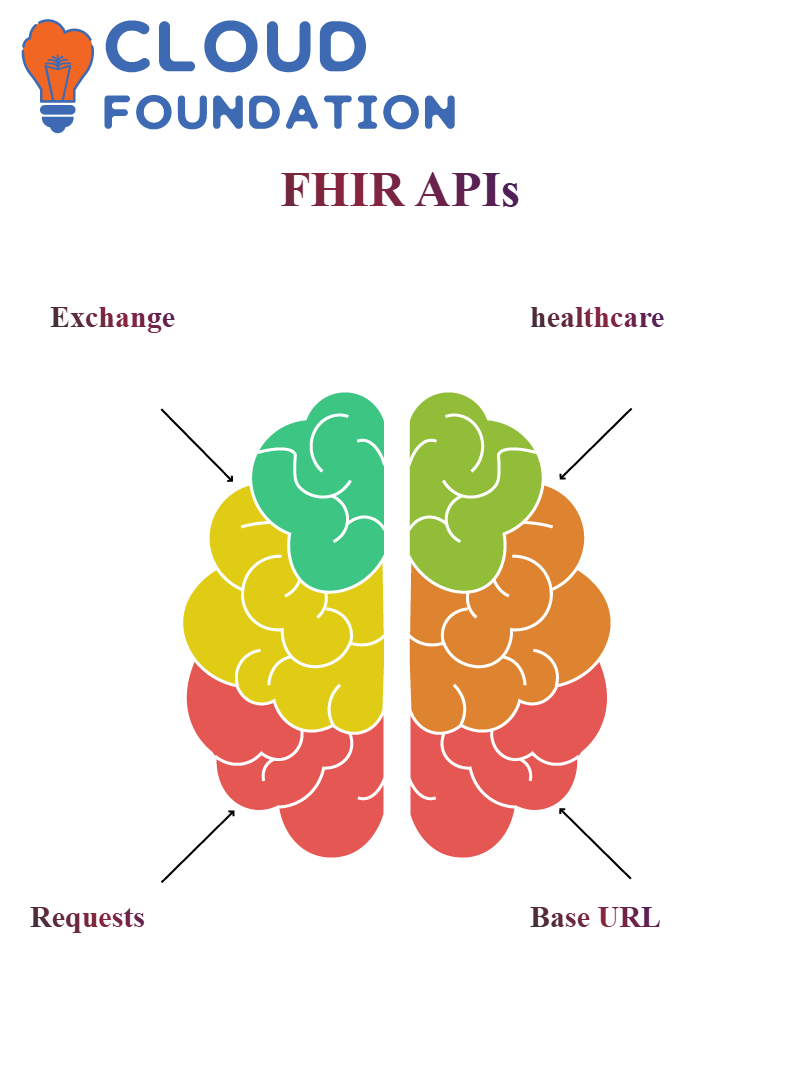
FHIR and HL7 APIs provided on the base URL enable seamless data interactions, making it essential to learn their intricacies for successful data processing and retrieval in healthcare systems.
FHIR HL7 in Data Mapping
FHIR/HL7 plays an invaluable role in healthcare data interoperability. Instead of manually building resources, tools provide automated mapping and transformation solutions.
FHIR and HL7 integration vary considerably based on their source data format; some systems utilise CSV files while others process HL7 messages. Regardless of its form, however, its ultimate goal remains the same – to convert structured FHIR resources from structured HL7 messages.
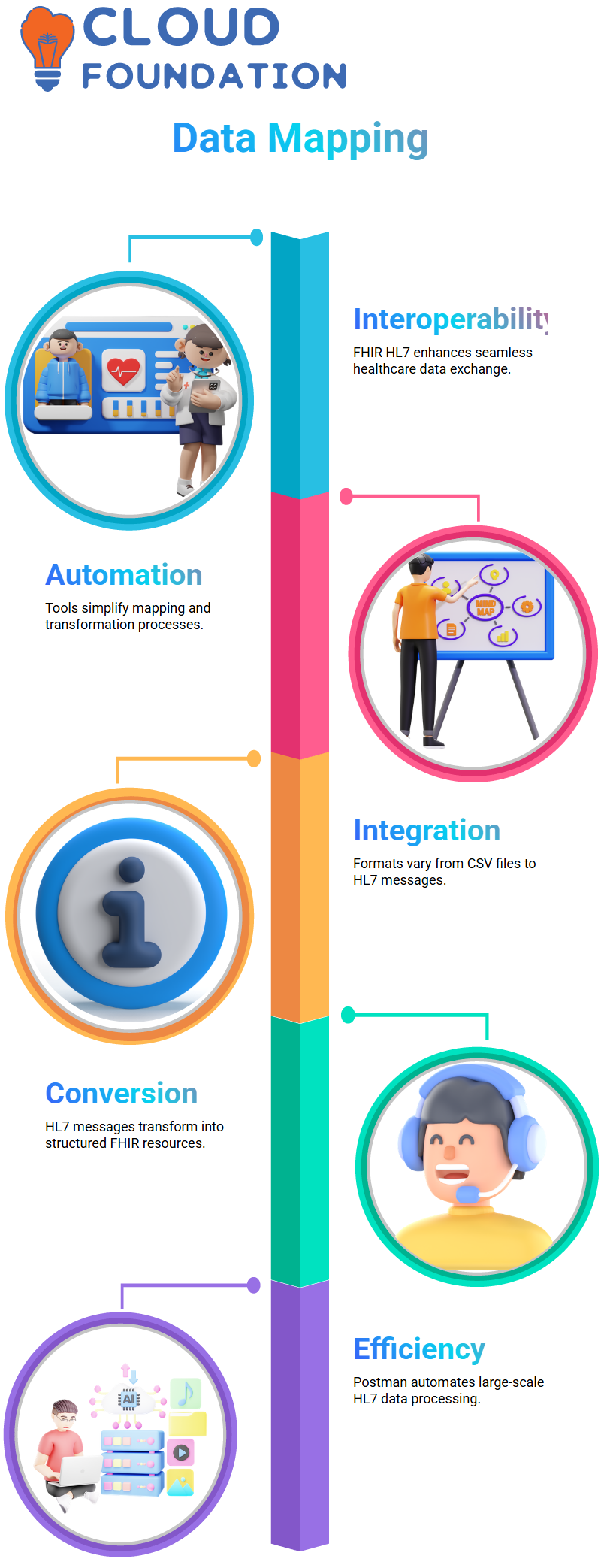
Postman makes sending HL7 messages easy. Even when handling thousands of rows simultaneously, the system efficiently maps data onto FHIR HL7 resources without requiring direct human involvement.
Data Transformation with FHIR HL7
FHIR HL7 provides prebuilt data models to make mapping and processing faster and simpler, without showing off code details; rather than showing how FHIR HL7 transforms raw HL7 data into structured outputs.
Mapping sheets provide essential context for understanding message segments such as PID and PV1, while FHIR HL7 ensures seamless data conversion from raw HL7 messages.
JavaScript-based mapping methods facilitate FHIR HL7 transformation with predefined schemas. Automation tools simplify the process of structuring FHIR HL7 resources by streamlining it.
FHIR HL7 Identifiers
Understanding resource identification when working with FHIR HL7 is imperative. There are two forms of identification, resource IDs and business identifiers.

Resource IDs are generated automatically when new resources are added to the system, while business identifiers are assigned externally (typically hospitals).
Imagine visiting a temple where your shoes are stored on a shoe rack with tokens representing each shoe, while they’re stored away. This concept works similarly with FHIR HL7 resource IDs; each resource ID means a unique record in your database.
Resource IDs in FHIR HL7
FHIR HL7 utilises Resource IDs as unique identifiers for resources within its system, ensuring seamless retrieval and management.
Each time someone submits a request to one of the FHIR HL7 server systems, a resource ID is automatically generated by this system and assigned as part of the request response process.
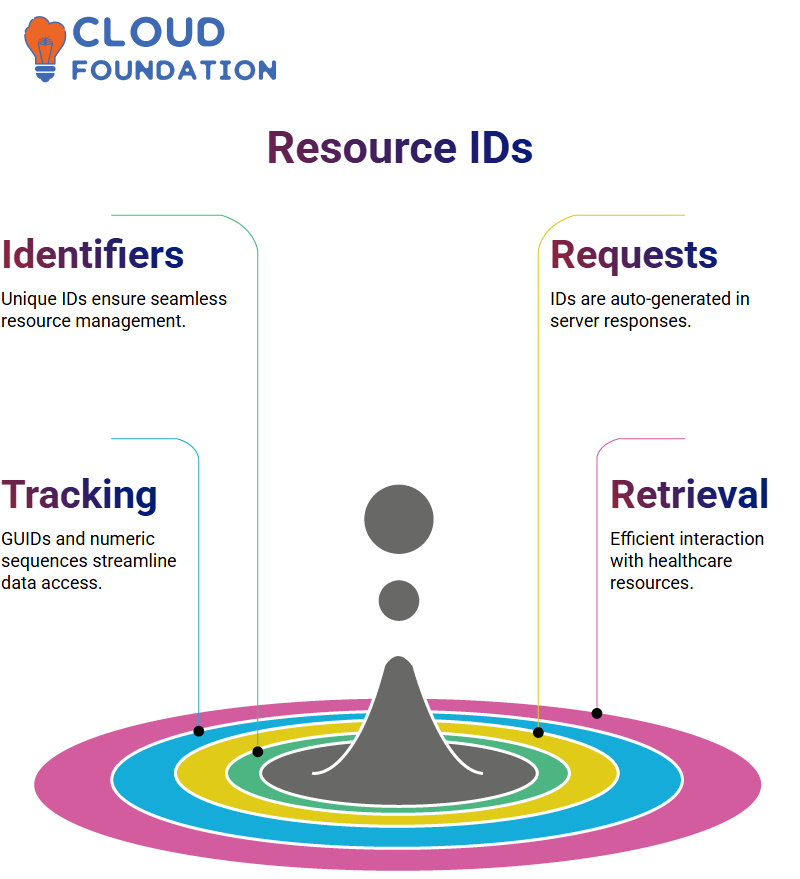
FHIR HL7 implementations often utilise globally unique identifiers (GUIDs) or numeric sequences as resource IDs to efficiently track, retrieve and interact with various healthcare data resources within FHIR HL7.
These IDs make tracking, retrieval and interaction much more straightforward and speedier than in previous implementations of either framework.
FHIR HL7 Using JavaScript
JavaScript enabled me to develop a basic script that quickly and accurately generates FHIR HL7 patient and encounter resources. PID mapping ensured accurate transference of unique ID values for patient resources.
The encounter resource refers to a patient resource using its unique identifier, thereby establishing a linkage.

Integration engine mappings are processed dynamically using predefined schemas for efficient structuring, ensuring seamless conversion from incoming HL7 messages into structured FHIR HL7 resources.
FHIR HL7 in ETL
Have you ever found yourself questioning how healthcare data can be efficiently organised and stored? That is where FHIR HL7 comes into play, especially when handling patient records, where transforming raw information into a structured format is critical. ETL processing plays a pivotal role here.
FHIR (HL7) ensures that health data is standardised and interoperable between systems. Consider having a database that exports CSV files containing patient demographics, medical histories, and other essential patient details. These files would then need to be extracted, transformed, and loaded efficiently for use by FHIR HL7 in an efficient manner.
How FHIR HL7 Enhances Data Extraction?
Data extraction is the initial step of ETL processing. Imagine working with a patient database: whenever you export information, CSV files with headers for different fields appear as results of exporting your patient records.

FHIR HL7 provides an extraction process that recognises key elements, including patient identifiers, names, and birth dates, to ensure accurate data capture as it awaits transformation.
FHIR HL7: Transforming Healthcare Data Management
The implementation of FHIR HL7 standards becomes essential when working with healthcare data, as my experience with Smile CDR has demonstrated. Delineating modules and setting delimiters was my initial step toward building out my system structure.
Within the system, a large editor enables custom script writing. A default method called “handle ETL Input Row”, for instance, operates on data coming in via a CSV file and stores it using input map as a storage mechanism while dynamically mapping headers and values.
By employing the log.info method, I ensured data processing started properly, allowing me to follow its transformation effectively. Next, I needed to select which FHIR HL7 resources to create using the resource Builder, which enabled me to produce patient resources quickly.
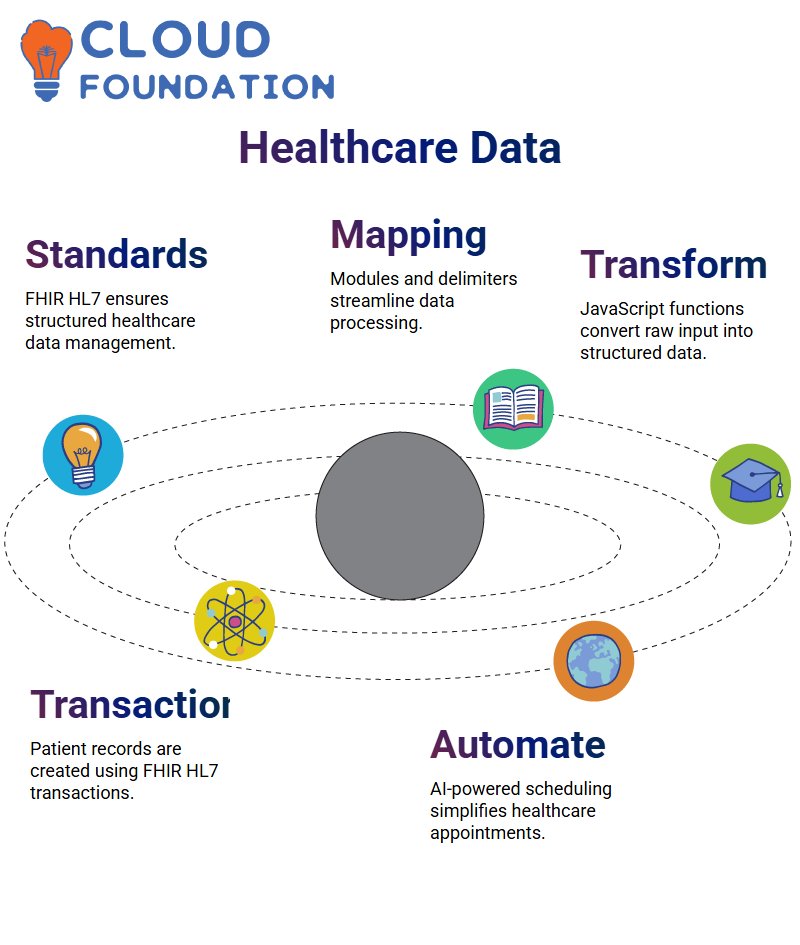
Each data field — whether patient ID, name, or birthdate — must be correctly mapped using FHIR HL7’s standard format to ensure compatibility with Smile CDR. By employing JavaScript functions within my platform, I transformed raw input into structured data fields.
An integral component was the transaction builder, responsible for creating patient records using the ‘Create Patient’ transaction to consolidate patient-related data into manageable payloads that could then be posted using FHIR/HL7 API calls to Smile CDR.
Smile CDR makes retrieving and writing data effortless through its FHIR/HL7 API interactions, with endpoint URLs facilitating seamless access to structured information for healthcare apps.
AI-powered appointment scheduling holds immense promise within the healthcare industry. Bots integrated with FHIR HL7 APIs enable patients to book appointments directly with practitioners, eliminating the need to navigate complex systems manually.
Practical Application of FHIR HL7 Identifiers
Let us imagine an FHIR HL7 scenario in which a patient record is created. The system generates an automatic Resource ID, while hospital personnel assign an MRN as its business identifier.
When retrieving patient information, both of these identifiers play distinct yet integral roles in retrieval efforts.
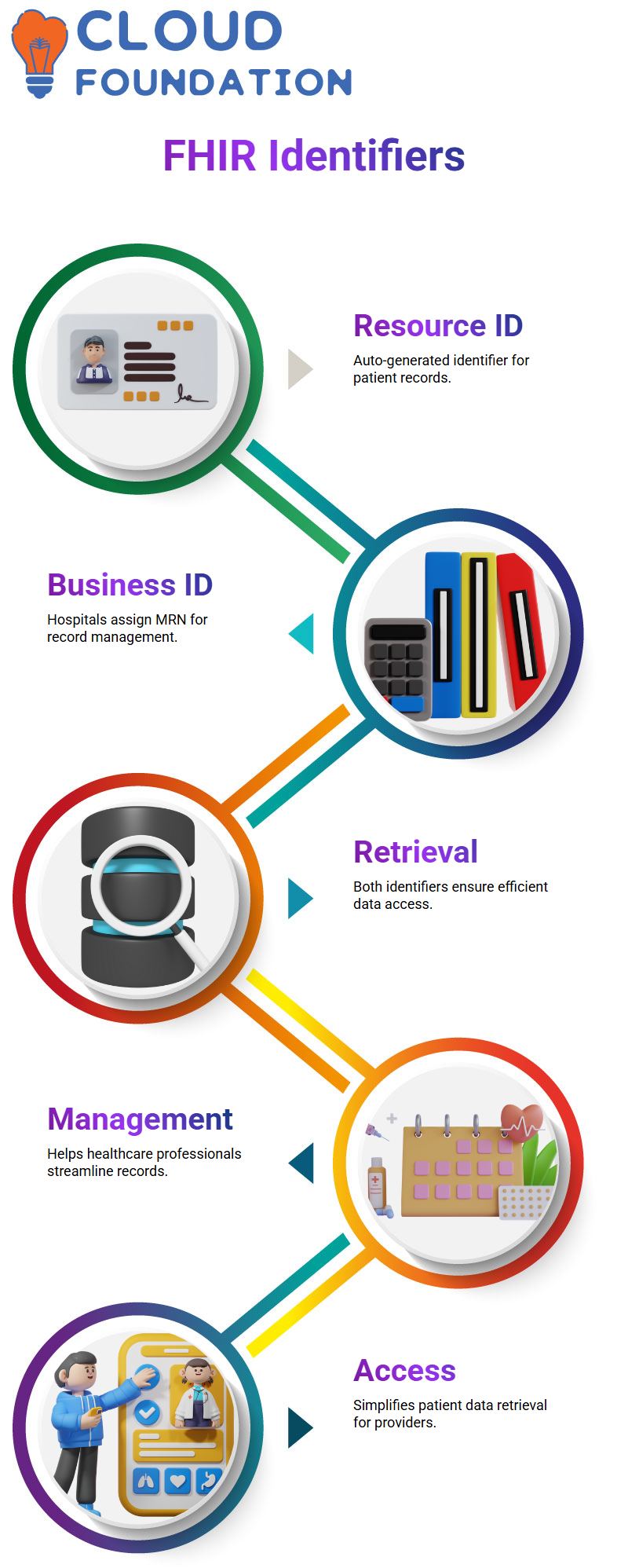
Healthcare professionals rely on FHIR HL7 identifiers to access patient data quickly. From retrieving records based on resource ID or business identifier, such as MRN, to efficiently managing patient records and accessing them easily, FHIR HL7 simplifies data access and management for healthcare providers.
FHIR HL7 Business Identifiers
Resource IDs are automatically assigned, while business identifiers can be externally determined values. A FHIR HL7 business identifier could represent any relevant number, such as MRN (Medical Record Number).
Returning to our shoe rack analogy, the token represents shoes stored, while its business identifier acts like the personal information associated with those shoes. Within FHIR HL7 systems, this business identifier ensures seamless mapping of patient data across various healthcare platforms.

Navya Chandrika
Author



